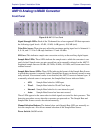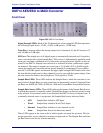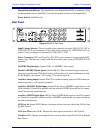
Euphonix System 5 Installation Guide System 5 Components
55
DM714 AES/EBU to MADI Converter
Front Panel
Figure 3-22 DM714 Front Panel
Signal Strength LEDs: Each of the 28 channels has a four-segment LED that represents
the following signal levels: -42 dB, -18 dB, -6 dB (green), -.05 dB (red).
Trim Pot: A trim pot adjusts the analog output level of channels A1 and A2 between +12
and +26 dBu in 2-dB steps.
SR Conv: The sample rate of all digital inputs is automatically detected and, if asynchro-
nous, converted to the system Sample Rate. This process is independently applied to each
stereo pair such that a combination of synchronous and asynchronous signals can be con-
nected to the DM714. Sample-rate conversion is switched off when synchronous signals
are detected. The range of sample-rate conversion is 32–56 kHz. 88.2 or 96 kHz signals
cannot be sample-rate converted and are passed through if synchronous. If non-synchro-
nous 88.2 or 96 kHz signals are detected, the upper signal strength LED flashes red to warn
the user that the sample rate for those channels is not in sync with the system settings. Sam-
ple-rate conversion reduces the bit depth in a 24-bit signal to 20 bits.
Sample Rate LEDs: These LEDs indicate the Sample Rate to which the converter is cur-
rently locked. Sample Rates are auto-sensed but can be manually selected. Supported Sam-
ple Rates are 96 kHz, 88.2 kHz, 48 kHz, 44.1 kHz and Custom Rates from external sources.
Sample Rate Source LEDs: These LEDs indicate the format of the Sample Rate Source
to which the converter is currently locked. Sample Rate Source can be auto-sensed or man-
ually selected. If an external source is not detected, the DM714 reverts to Internal sync. If
a manually selected source is not present, the Sample Rate Source indicator blinks.
• AES: Sample Rate locked to AES Input.
• Word: Sample Rate locked to Word Clock Input.
• Internal: Sample Rate locked to its own internal crystal.
• Auto: Sample Rate Source has been auto-sensed.
These LEDs appear in the same order in which signals are tested for presence. This de-
tection procedure occurs when the converters are powered on. The Sample Rate and Sam-
ple Rate Source can also be selected manually.


















